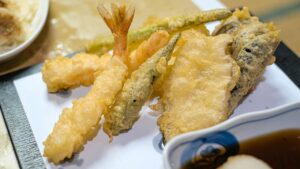What is tempura? History & where to try?

What is wagyu beef? – Buy best halal a5 beef in kl
October 2, 202425 Romantic dinner in kl update 2025
October 2, 2024Welcome to our exploration of tempura, the delicious Japanese Food dish that features lightly battered and deep-fried vegetables and seafood! In this blog, we’ll delve into the fascinating history of tempura, tracing its origins and evolution over the years.
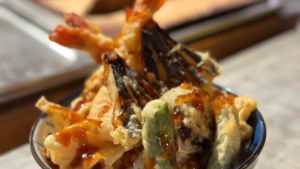
What is tempura?
Tempura is a popular Japanese dish that consists of seafood, vegetables, or other ingredients that are lightly battered and deep-fried to a crispy, golden texture. The batter is typically made from a simple mixture of cold water, flour, and sometimes egg, which results in a light, airy coating that doesn’t overpower the flavor of the main ingredient.
Common tempura ingredients include shrimp, squid, sweet potatoes, eggplant, and mushrooms. The key to excellent tempura is frying it at the right temperature so that the batter remains crisp while the inside is tender and juicy. Tempura is often served with a dipping sauce called tentsuyu, which is made from a combination of soy sauce, mirin (a type of rice wine), and dashi (a Japanese soup stock), along with grated radish for added flavor. It’s enjoyed as a standalone dish or as part of a larger meal, such as tempura udon or tempura donburi (tempura rice bowl).
Type of tempura
Tempura comes in a delightful array of variations, each showcasing different ingredients and preparation methods. Traditionally, the dish features a mix of seafood and seasonal vegetables, but the possibilities are nearly endless!
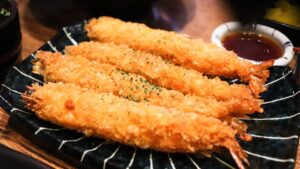
Seafood Tempura:
- Ebi (Shrimp) Tempura: The most iconic type of tempura, made with large prawns that are battered and fried until crispy.
- Ika (Squid) Tempura: Squid rings or slices fried in tempura batter, known for their tender texture.
- Kani (Crab) Tempura: Made with fresh crab meat or crab sticks, offering a sweet and savory taste.
- Anago (Conger Eel) Tempura: Light and flavorful, anago tempura is commonly enjoyed for its delicate texture.
- Sakana (Fish) Tempura: Various white fish, such as flounder or snapper, are often used in tempura dishes.
Vegetable Tempura:
- Kabocha (Pumpkin) Tempura: Thin slices of sweet pumpkin with a crisp batter.
- Nasu (Eggplant) Tempura: Eggplant is lightly fried to maintain its soft interior while offering a crispy exterior.
- Sweet Potato Tempura: Thick slices of sweet potato create a naturally sweet and satisfying bite.
- Shiso (Perilla Leaf) Tempura: A light and fragrant herb, Shiso leaves are fried to a crisp but retain their fresh, minty flavor.
- Mushroom Tempura: Shiitake or enoki mushrooms are commonly fried to bring out their umami flavor.
- Carrot Tempura: Thinly sliced or julienned carrots, providing a crunchy texture.
Mixed Tempura:
- Kakiage: A mixed tempura fritter made from a combination of chopped seafood and vegetables, often held together by the batter.
History of tempura
Tempura has a fascinating history that dates back to the 16th century. It was introduced to Japan by Portuguese missionaries and traders who brought the technique of frying food in batter. The word “tempura” is believed to derive from the Latin phrase “tempora,” referring to the Ember Days when Catholics abstain from meat and consumed fried fish instead.
As this cooking method spread, it was adapted by Japanese cooks, who refined the technique to suit local ingredients and tastes. By the Edo period (1603-1868), tempura had become a popular street food, especially in urban areas like Edo (modern-day Tokyo). Vendors would serve freshly fried items, often using seasonal vegetables and seafood.
Tempura’s light, crispy texture and vibrant presentation made it a favorite among locals. Over time, it transitioned from street food to a staple in restaurants, where chefs began to emphasize the art of tempura, focusing on perfecting the batter and frying techniques.
Today, tempura remains a significant part of Japanese cuisine, enjoyed both in traditional settings and as a part of contemporary dishes around the world.
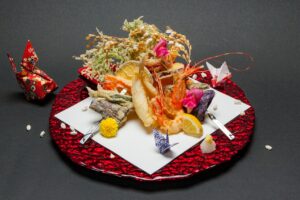
Where to try tempura in Kuala Lumpur?
Kuala Lumpur is home to a vibrant dining scene that features a variety of restaurants offering delicious tempura. Whether you’re seeking a casual eatery or an upscale dining experience, the city has something for everyone.
1.Nobu Kuala Lumpur
Nobu Kuala Lumpur is a renowned fine-dining restaurant that offers a unique blend of traditional Japanese cuisine with Peruvian influences, a hallmark of the global Nobu brand. Located in the heart of Kuala Lumpur, the restaurant provides a sophisticated dining experience with stunning views of the city skyline, including the iconic Petronas Towers.
At Nobu KL, diners can indulge in signature dishes such as Black Cod Miso, Yellowtail Jalapeño, and Tiradito, which highlight the fusion of Japanese and South American flavors. The restaurant also offers a premium omakase (chef’s tasting menu), where the chef selects and prepares a series of courses that showcase the freshest ingredients and most creative presentations.
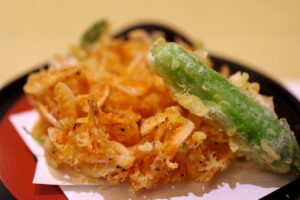
With its elegant ambiance, impeccable service, and innovative cuisine, Nobu Kuala Lumpur is a top destination for those seeking a luxurious and memorable dining experience. Whether for a special occasion or a refined night out, it continues to be one of the leading fine-dining restaurants in Malaysia.
2.Sushi Tei
Sushi Tei is a popular Japanese restaurant chain known for offering a wide variety of sushi, sashimi, and other traditional Japanese dishes in a casual, family-friendly setting. With multiple locations across Asia, including Kuala Lumpur, Sushi Tei combines fresh, high-quality ingredients with contemporary Japanese flavors, making it a go-to spot for sushi lovers.
The menu at Sushi Tei features a broad range of offerings, from classic sushi rolls and nigiri to inventive fusion dishes. Signature items include salmon sashimi, spider rolls (soft-shell crab), and a variety of tempura and donburi (rice bowls). Beyond sushi, the restaurant also serves hot dishes like ramen, udon, and teppanyaki, catering to various tastes.
The modern yet relaxed ambiance, along with the wide-ranging menu, makes Sushi Tei an ideal dining destination for casual meals, family gatherings, or even business lunches. With consistently fresh ingredients and excellent service, Sushi Tei has built a reputation as a reliable and enjoyable Japanese dining experience.
3.Rakuzen
Rakuzen is a well-known Japanese restaurant in Kuala Lumpur, celebrated for its authentic and high-quality Japanese cuisine. With multiple locations throughout the city, Rakuzen offers a diverse menu that includes traditional sushi, sashimi, and an array of Japanese dishes prepared with fresh ingredients imported from Japan.
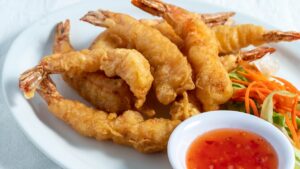
At Rakuzen, diners can enjoy a variety of specialties such as chirashi don (sashimi rice bowl), grilled seafood, tempura, and teppanyaki. The restaurant is also famous for its elegantly prepared sushi platters, which feature a wide selection of seasonal fish and other delicacies. In addition to seafood, the menu offers various options like Wagyu beef, teriyaki dishes, and noodles such as udon and soba.
The ambiance at Rakuzen is refined yet comfortable, making it suitable for both casual meals and special occasions. With its commitment to delivering authentic flavors and meticulous presentation, Rakuzen remains a top choice for Japanese cuisine enthusiasts in Kuala Lumpur.
Summary
From authentic Japanese restaurants to trendy fusion spots, you can find tempura made with the freshest ingredients and expertly crafted batter. Join us as we highlight some of the best places in KL to savor this delightful dish, ensuring that your tempura experience is both memorable and delicious!
We’ll highlight some of the best places to experience authentic tempura, whether you’re a longtime fan or new to this crispy delight. Join us as we uncover the art and flavors of tempura!


